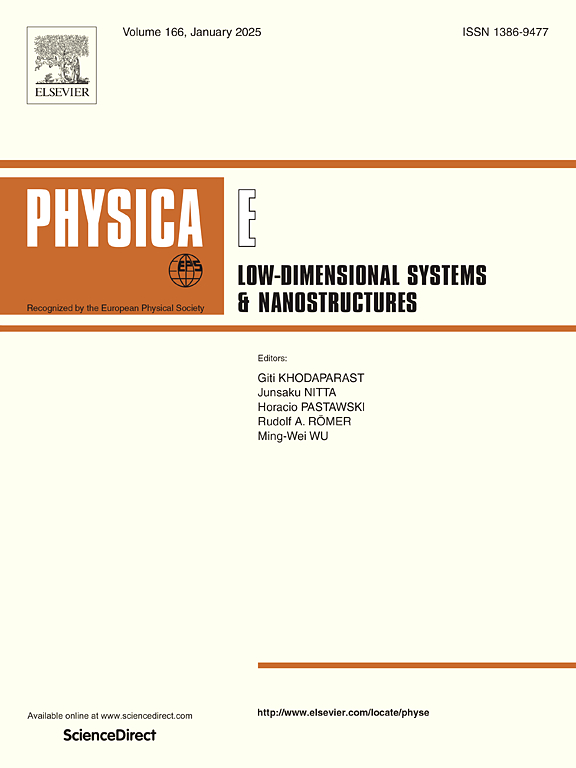Magneto-optical absorption properties of silicene: Equations of motion method
IF 2.9
3区 物理与天体物理
Q3 NANOSCIENCE & NANOTECHNOLOGY
Physica E-low-dimensional Systems & Nanostructures
Pub Date : 2025-05-19
DOI:10.1016/j.physe.2025.116290
引用次数: 0
Abstract
In this study, we explore the magneto-optical response of monolayer silicene subjected to perpendicular electric and magnetic fields by analyzing its optical response functions derived through the equation of motion approach. Both intraband and interband transitions are analyzed in detail. Our results show that the absorption spectrum is highly sensitive to the electron density, which controls the Fermi level and thereby determines the possible optical transitions. At high electron densities, the first interband transition peak shifts to higher energies, while the intraband peaks become more pronounced due to the reduced transition energies. The response also shows strong polarization dependence: left-handed circular polarization enhances absorption, while right-handed polarization suppresses it. A characteristic “half-peak” structure arises from asymmetric Pauli blocking. Magnetic fields effectively modulate peak positions and intensities, whereas electric fields play a lesser role under strong quantization. These findings highlight silicene’s tunability for infrared and terahertz optoelectronic applications.
硅烯的磁光吸收特性:运动方程法
在本研究中,我们通过分析由运动方程方法导出的单层硅烯的光响应函数,探讨了垂直电场和磁场作用下单层硅烯的磁光响应。详细分析了带内和带间的跃迁。我们的结果表明,吸收光谱对电子密度高度敏感,电子密度控制费米能级,从而决定可能的光学跃迁。在高电子密度下,第一个带间跃迁峰向更高的能量移动,而带内峰由于跃迁能量的降低而变得更加明显。响应也表现出强烈的偏振依赖性:左手圆偏振增强吸收,而右手圆偏振抑制吸收。非对称泡利阻塞产生了典型的“半峰”结构。磁场可以有效地调制峰值位置和强度,而电场在强量子化下的作用较小。这些发现突出了硅烯在红外和太赫兹光电应用中的可调性。
本文章由计算机程序翻译,如有差异,请以英文原文为准。
求助全文
约1分钟内获得全文
求助全文
来源期刊
CiteScore
7.30
自引率
6.10%
发文量
356
审稿时长
65 days
期刊介绍:
Physica E: Low-dimensional systems and nanostructures contains papers and invited review articles on the fundamental and applied aspects of physics in low-dimensional electron systems, in semiconductor heterostructures, oxide interfaces, quantum wells and superlattices, quantum wires and dots, novel quantum states of matter such as topological insulators, and Weyl semimetals.
Both theoretical and experimental contributions are invited. Topics suitable for publication in this journal include spin related phenomena, optical and transport properties, many-body effects, integer and fractional quantum Hall effects, quantum spin Hall effect, single electron effects and devices, Majorana fermions, and other novel phenomena.
Keywords:
• topological insulators/superconductors, majorana fermions, Wyel semimetals;
• quantum and neuromorphic computing/quantum information physics and devices based on low dimensional systems;
• layered superconductivity, low dimensional systems with superconducting proximity effect;
• 2D materials such as transition metal dichalcogenides;
• oxide heterostructures including ZnO, SrTiO3 etc;
• carbon nanostructures (graphene, carbon nanotubes, diamond NV center, etc.)
• quantum wells and superlattices;
• quantum Hall effect, quantum spin Hall effect, quantum anomalous Hall effect;
• optical- and phonons-related phenomena;
• magnetic-semiconductor structures;
• charge/spin-, magnon-, skyrmion-, Cooper pair- and majorana fermion- transport and tunneling;
• ultra-fast nonlinear optical phenomena;
• novel devices and applications (such as high performance sensor, solar cell, etc);
• novel growth and fabrication techniques for nanostructures

 求助内容:
求助内容: 应助结果提醒方式:
应助结果提醒方式:


